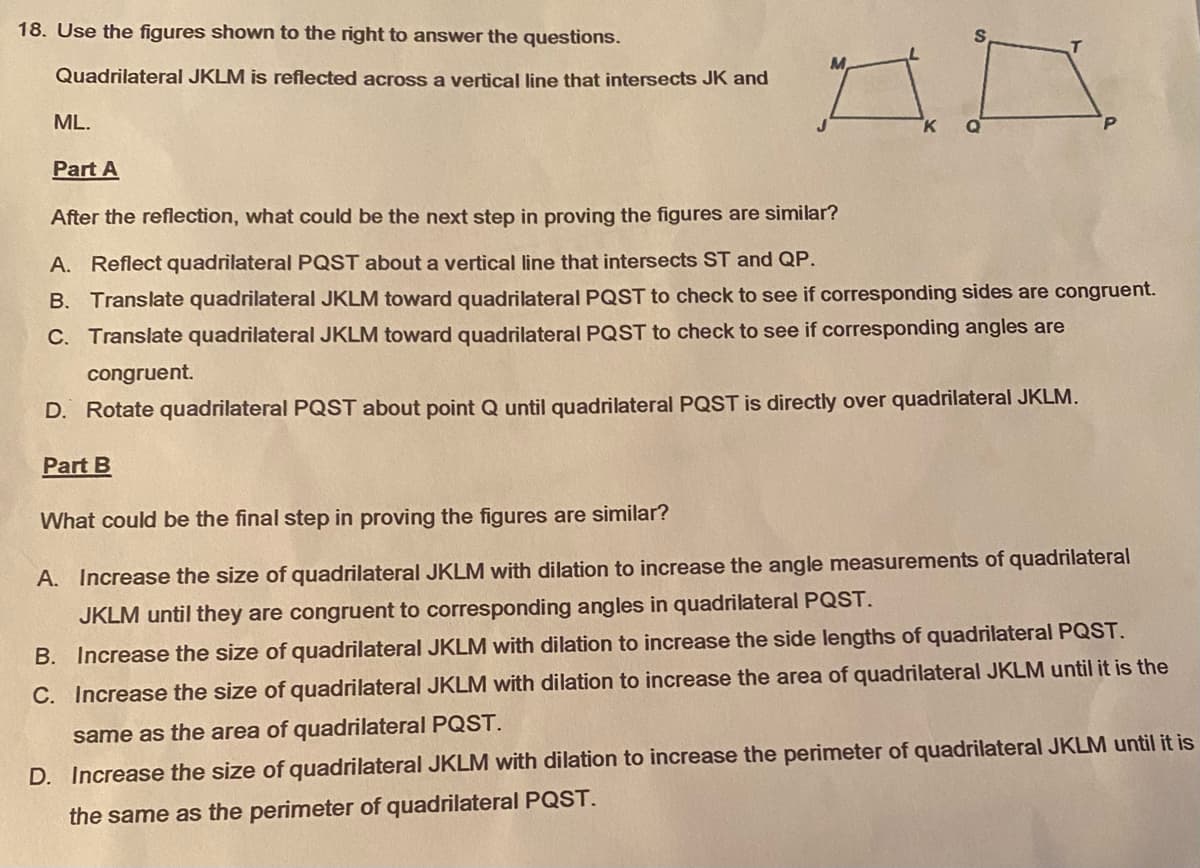18. Use the figures shown to the right to answer the questions. Quadrilateral JKLM is reflected across a vertical line that intersects JK and ML. Part A After the reflection, what could be the next step in proving the figures are similar? A. Reflect quadrilateral PQST about a vertical line that intersects ST and QP. B. Translate quadrilateral JKLM toward quadrilateral PQST to check to see if corresponding sides are congruent. C. Translate quadrilateral JKLM toward quadrilateral PQST to check to see if corresponding angles are congruent. D. Rotate quadrilateral PQST about point Q until quadrilateral PQST is directly over quadrilateral JKLM. Part B What could be the final step in proving the figures are similar? A. Increase the size of quadrilateral JKLM with dilation to increase the angle measurements of quadrilateral JKLM until they are congruent to corresponding angles in quadrilateral PQST. B. Increase the size of quadrilateral JKLM with dilation to increase the side lengths of quadrilateral PQST. C. Increase the size of quadrilateral JKLM with dilation to increase the area of quadrilateral JKLM until it is the same as the area of quadrilateral PQST. D. Increase the size of quadrilateral JKLM with dilation to increase the perimeter of quadrilateral JKLM until it is the same as the perimeter of quadrilateral PQST.
18. Use the figures shown to the right to answer the questions. Quadrilateral JKLM is reflected across a vertical line that intersects JK and ML. Part A After the reflection, what could be the next step in proving the figures are similar? A. Reflect quadrilateral PQST about a vertical line that intersects ST and QP. B. Translate quadrilateral JKLM toward quadrilateral PQST to check to see if corresponding sides are congruent. C. Translate quadrilateral JKLM toward quadrilateral PQST to check to see if corresponding angles are congruent. D. Rotate quadrilateral PQST about point Q until quadrilateral PQST is directly over quadrilateral JKLM. Part B What could be the final step in proving the figures are similar? A. Increase the size of quadrilateral JKLM with dilation to increase the angle measurements of quadrilateral JKLM until they are congruent to corresponding angles in quadrilateral PQST. B. Increase the size of quadrilateral JKLM with dilation to increase the side lengths of quadrilateral PQST. C. Increase the size of quadrilateral JKLM with dilation to increase the area of quadrilateral JKLM until it is the same as the area of quadrilateral PQST. D. Increase the size of quadrilateral JKLM with dilation to increase the perimeter of quadrilateral JKLM until it is the same as the perimeter of quadrilateral PQST.
Elementary Geometry For College Students, 7e
7th Edition
ISBN:9781337614085
Author:Alexander, Daniel C.; Koeberlein, Geralyn M.
Publisher:Alexander, Daniel C.; Koeberlein, Geralyn M.
Chapter4: Quadrilaterals
Section4.3: The Rectangle, Square, And Rhombus
Problem 42E: a Argue that the midpoint of the hypotenuse of a right triangle is equidistant from the three...
Related questions
Question

Transcribed Image Text:18. Use the figures shown to the right to answer the questions.
Quadrilateral JKLM is reflected across a vertical line that intersects JK and
ML.
Part A
After the reflection, what could be the next step in proving the figures are similar?
A. Reflect quadrilateral PQST about a vertical line that intersects ST and QP.
B. Translate quadrilateral JKLM toward quadrilateral PQST to check to see if corresponding sides are congruent.
C. Translate quadrilateral JKLM toward quadrilateral PQST to check to see if corresponding angles are
congruent.
D. Rotate quadrilateral PQST about point Q until quadrilateral PQST is directly over quadrilateral JKLM.
Part B
What could be the final step in proving the figures are similar?
A. Increase the size of quadrilateral JKLM with dilation to increase the angle measurements of quadrilateral
JKLM until they are congruent to corresponding angles in quadrilateral PQST.
B. Increase the size of quadrilateral JKLM with dilation to increase the side lengths of quadrilateral PQST.
C. Increase the size of quadrilateral JKLM with dilation to increase the area of quadrilateral JKLM until it is the
same as the area of quadrilateral PQST.
D. Increase the size of quadrilateral JKLM with dilation to increase the perimeter of quadrilateral JKLM until it is
the same as the perimeter of quadrilateral PQST.
Expert Solution
This question has been solved!
Explore an expertly crafted, step-by-step solution for a thorough understanding of key concepts.
This is a popular solution!
Trending now
This is a popular solution!
Step by step
Solved in 2 steps

Recommended textbooks for you

Elementary Geometry For College Students, 7e
Geometry
ISBN:
9781337614085
Author:
Alexander, Daniel C.; Koeberlein, Geralyn M.
Publisher:
Cengage,

Mathematics For Machine Technology
Advanced Math
ISBN:
9781337798310
Author:
Peterson, John.
Publisher:
Cengage Learning,

Elementary Geometry for College Students
Geometry
ISBN:
9781285195698
Author:
Daniel C. Alexander, Geralyn M. Koeberlein
Publisher:
Cengage Learning

Elementary Geometry For College Students, 7e
Geometry
ISBN:
9781337614085
Author:
Alexander, Daniel C.; Koeberlein, Geralyn M.
Publisher:
Cengage,

Mathematics For Machine Technology
Advanced Math
ISBN:
9781337798310
Author:
Peterson, John.
Publisher:
Cengage Learning,

Elementary Geometry for College Students
Geometry
ISBN:
9781285195698
Author:
Daniel C. Alexander, Geralyn M. Koeberlein
Publisher:
Cengage Learning

Holt Mcdougal Larson Pre-algebra: Student Edition…
Algebra
ISBN:
9780547587776
Author:
HOLT MCDOUGAL
Publisher:
HOLT MCDOUGAL